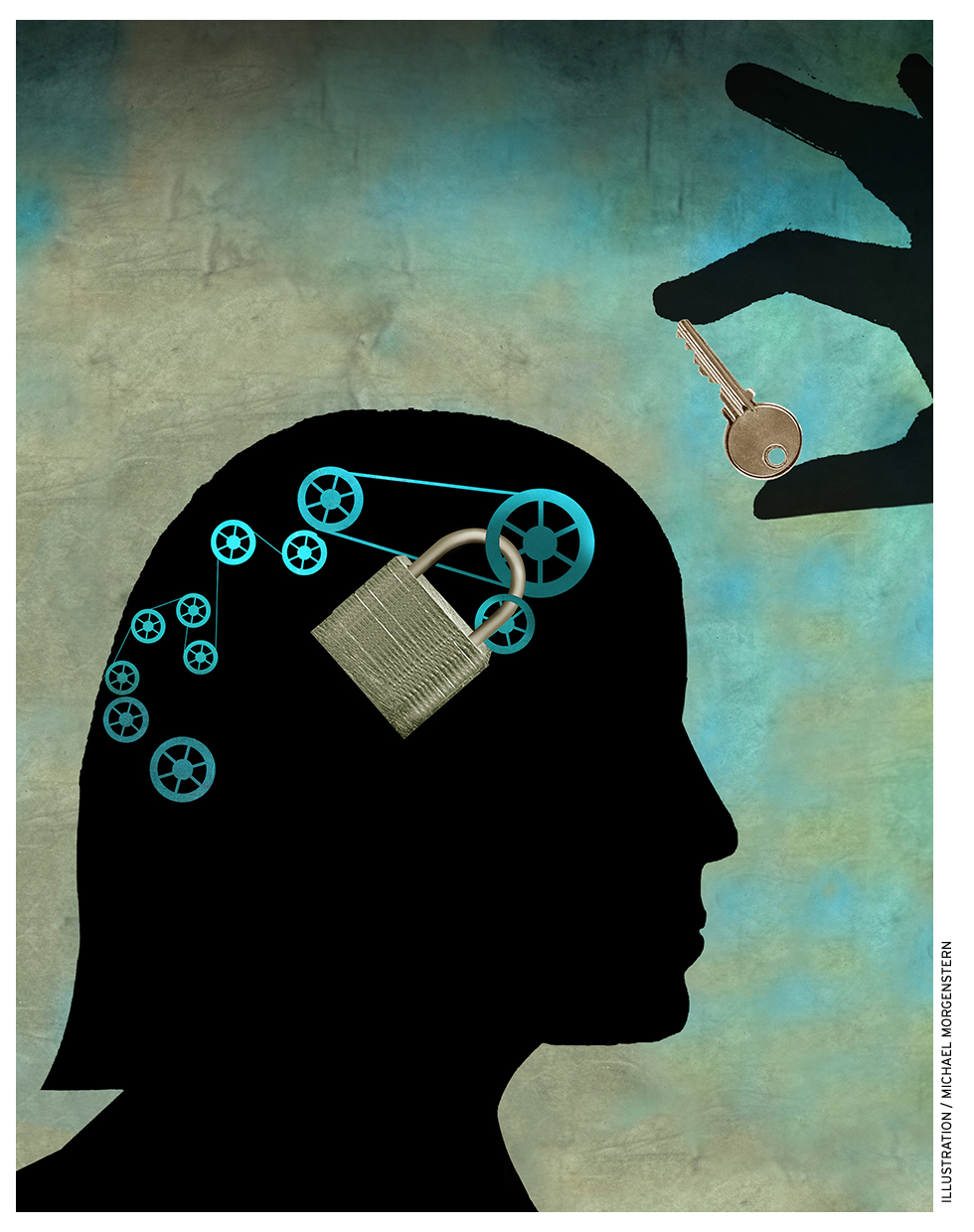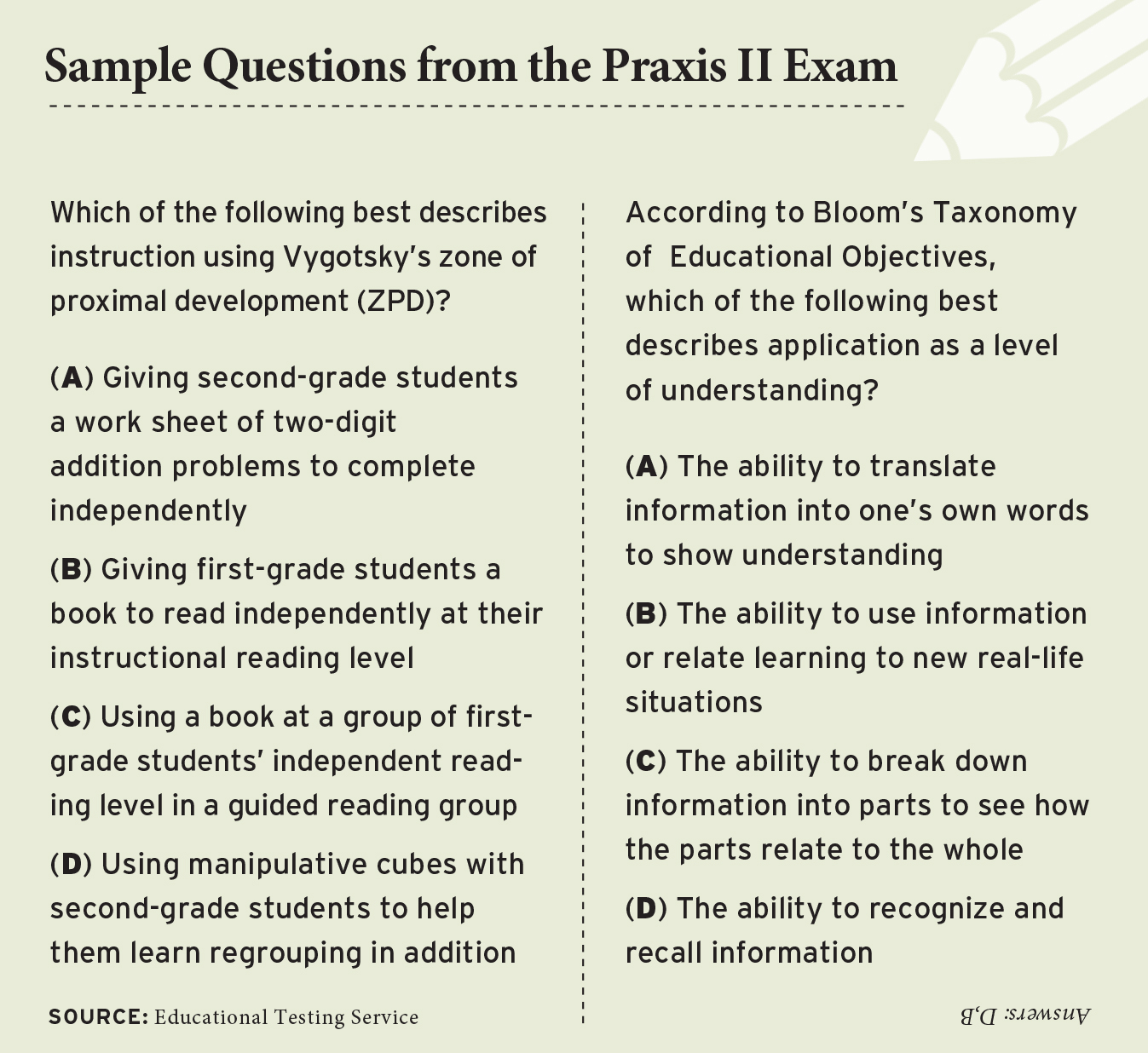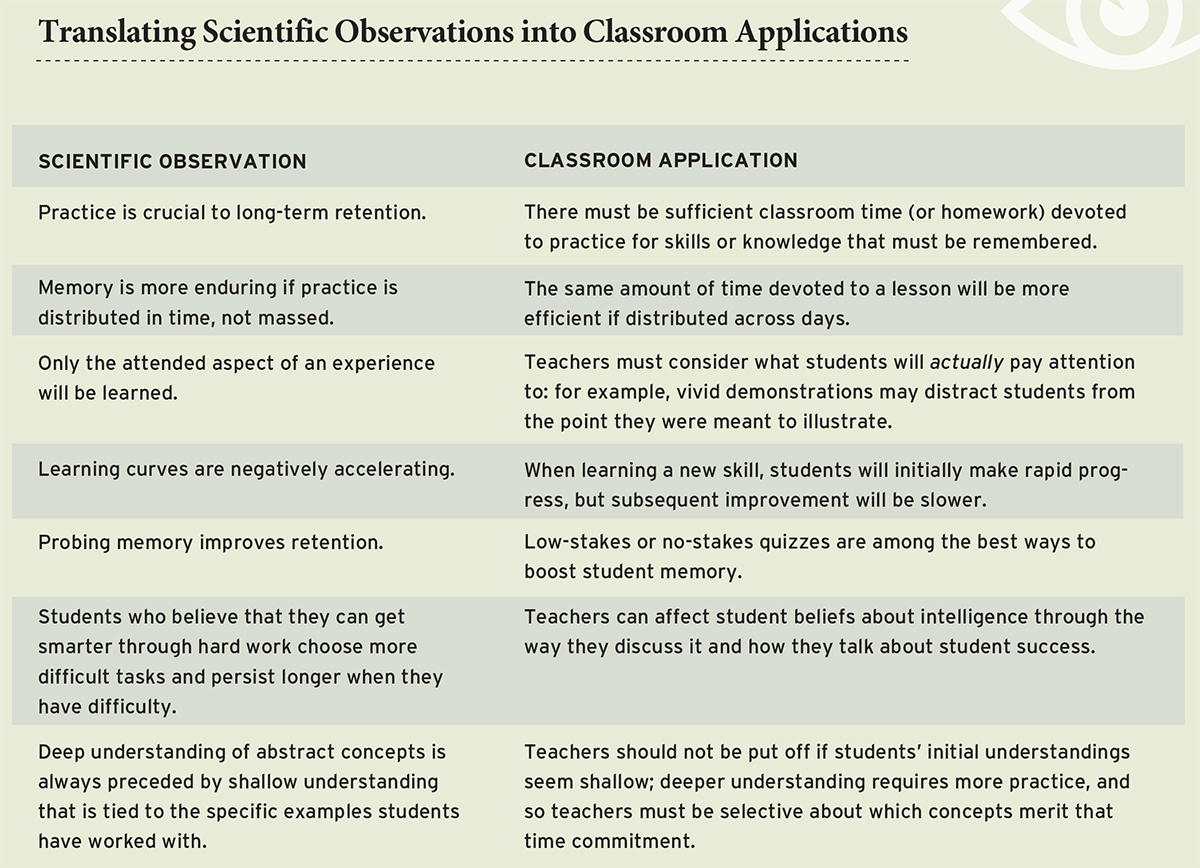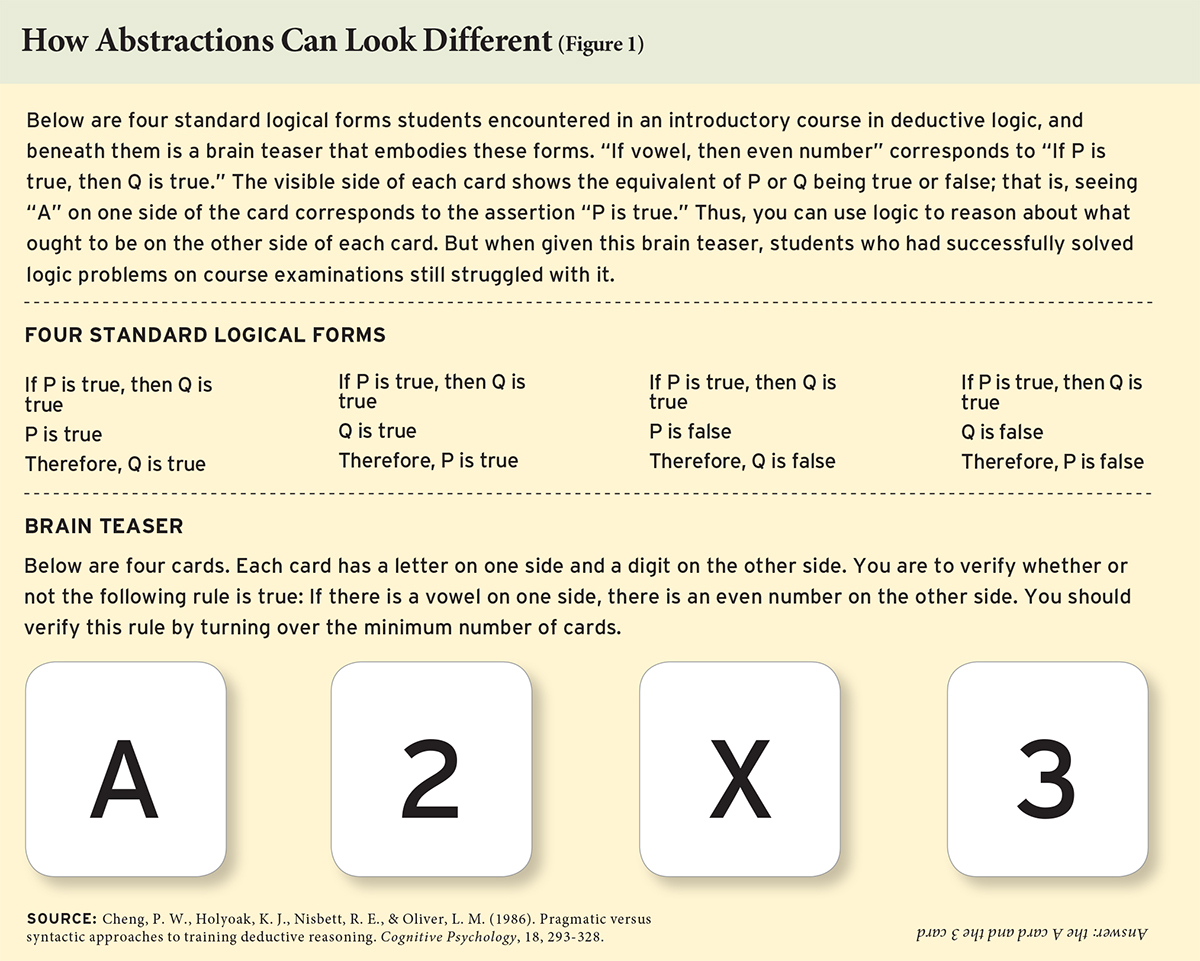 In 2002 I was invited to give a talk to 500 school teachers. The invitation puzzled me, as my research at the time had nothing to do with education; I was a psychologist studying how different parts of the brain support different types of human learning. I mentioned this to the person who invited me, and she said, “We know. We want you to tell us about cognitive psychology. We think our teachers would be interested.” I shrugged, accepted the invitation, and forgot about it. Six months later (and days before I was to give the talk) I was wondering what had possessed me to say yes. Surely teachers would already know anything I could tell them about human memory, or attention, or motivation that would be relevant to teaching. I felt anxious and was sure the presentation would be a disaster.
In 2002 I was invited to give a talk to 500 school teachers. The invitation puzzled me, as my research at the time had nothing to do with education; I was a psychologist studying how different parts of the brain support different types of human learning. I mentioned this to the person who invited me, and she said, “We know. We want you to tell us about cognitive psychology. We think our teachers would be interested.” I shrugged, accepted the invitation, and forgot about it. Six months later (and days before I was to give the talk) I was wondering what had possessed me to say yes. Surely teachers would already know anything I could tell them about human memory, or attention, or motivation that would be relevant to teaching. I felt anxious and was sure the presentation would be a disaster.
But it wasn’t. Teachers thought it was interesting and relevant to their practice. Most surprising to me, they were unfamiliar with the content, even though it came from the very first class in human cognition a college student would take. I wondered: how could teachers not know the ABCs of cognition?
Yet the following 15 years have shown that experience was not a fluke. I’ve written four books and dozens of articles and have delivered scores of talks for teachers on the basics of cognition. In so doing, I’ve addressed what teachers saw as a need; what I haven’t done is think about why the need exists. Shouldn’t teachers learn how children think during their training? In this essay I consider why they don’t, and what we might do about it.
What Should Teachers Know?
Is my experience representative? Are most teachers unaware of the latest findings from basic science—in particular, psychology—about how children think and learn? Research is limited, but a 2006 study by Arthur Levine indicated that teachers were, for the most part, confident about their knowledge: 81 percent said they understood “moderately well” or “very well” how students learn. But just 54 percent of school principals rated the understanding of their teachers that high. And a more recent study of 598 American educators by Kelly Macdonald and colleagues showed that both assessments may be too optimistic. A majority of the respondents held misconceptions about learning—erroneously believing, for example, that children have learning styles dominated by one of the senses, that short bouts of motor-coordination exercises can improve the integration of the brain’s left and right hemispheres, and that children are less attentive after consuming sugary drinks or snacks.
But perhaps when teachers say they “know how children learn,” they are not talking about learning from a scientific perspective but about craft knowledge. They take the question to mean, “Do you know how to ensure that children in your classroom learn?” which is not the same as understanding the theoretical principles of psychology. In fact, in a 2012 study of 500 new teachers by the American Federation of Teachers (AFT), respondents said that their training was too theoretical and didn’t prepare them for teaching “in the real world.” Maybe they have a point. Perhaps teachers don’t need generalized theories and abstractions, but rather ready-to-go strategies—not information about how children learn, but the best way to teach fractions; not how children process negative emotion, but what to say to a 3rd grader who is dejected about his reading.
Most education researchers disagree, and they offer a reasonable argument. Some situations a teacher will encounter are predictable—a future teacher of 4th graders knows she will teach fractions—but many other situations are not. All teachers face problems for which their education leaves them unprepared: a 2nd grader goes to a corner of the room and spins, or a group of 6th graders laughs at a classmate because he whispers to himself when he reads. At these unpredictable moments, the teacher must improvise. How she responds to a child in a novel situation will depend, in part, on her beliefs about the cognitions, emotions, and motivations of children. In fact, future teachers have views about how children learn even before they begin their teacher-education programs. One goal of teacher education, then, is to ensure that these beliefs are as accurate as possible.
Whether for this reason or others, most teacher-education programs require some coursework in educational psychology. More important, every state requires that teachers pass an exam as part of the licensing process, and psychological content appears on most of these tests. For example, the publisher’s study guide for the Praxis II exam (used in more than 30 states) includes a list of psychological principles that test-takers should know (such as “how knowledge is constructed”), as well as the work of theorists (such as Bandura, Piaget, Bruner) and psychological terms (such as schema, zone of proximal development, operant conditioning). Two sample questions from this exam appear in the sidebar.
In sum, many U.S. teachers report that their education is overly theoretical and not of great utility. It’s clear that they are required to learn some basic principles of psychology as part of that education, but it is not clear that practicing teachers remember what they were taught.

Reform in Teacher Education
If a large percentage of teachers forget what they learn, that might be taken as evidence for the weakness of teacher preparation. Certainly, teachers’ lack of retention is consistent with the finding that teacher coursework predicts student outcomes poorly. Likewise, some research indicates that licensure test scores are associated with student outcomes, but those scores may simply be a proxy for a teacher’s cognitive ability. More generally, the lack of data showing the effectiveness of traditional teacher education might be viewed as support for policies that limit or eliminate the requirement that teachers undergo traditional teacher preparation. If we suspect teachers forget important aspects of their training and we know teachers without this preparation are mostly indistinguishable from those who get it, why set this meaningless hurdle? Requiring the coursework and a passing grade on a licensure test serves only to incur costs in time and money to future teachers, potentially closing the profession to some candidates. Given that some groups (such as African American men) are underrepresented in the profession, and that there are teacher shortages in certain geographic regions and subject areas, the requirement seems counterproductive.
Other observers have suggested that teacher education shouldn’t be eliminated, but it should be refocused. Current programs emphasize abstract theory at the expense of practical knowledge. There is, by this argument, only so much that can be learned from textbooks and lectures. Teaching is a skill, like tennis, that requires doing to gain proficiency. No one would think of teaching a child to play tennis by starting with a couple of years of book learning and no court time. Little wonder that teachers say their education overemphasized theory. These considerations point to greater emphasis on student-teaching placements, although existing research does not show that such apprenticeships necessarily lead to better student outcomes.
I suggest a third point of view. There’s reason for optimism that knowledge of the basic science of learning can improve teaching, and ultimately, student outcomes. Optimism, not confidence, because there is little direct evidence bearing on the question. Nevertheless, research does show that teacher beliefs influence their classroom decisions, so it is not a wild notion to suppose that accurate beliefs about how children learn will lead to better classroom decisions than inaccurate beliefs will.
The problem, I suggest, is twofold, and lies in the details of what future teachers learn, and how they learn it. Teachers are asked to learn content that is appropriate for future scientists, not future practitioners. And future teachers do not get sufficient practice with the concepts they are taught.
Science versus Application
What must scientists know? Scientists develop theories to account for observations. Observations come from the inspection and measurement of the world, inside the laboratory and out. A theory is a small set of statements that summarizes a large set of observations. Newton observed the movement of objects in many different circumstances, and summarized how they move with three laws of motion.
Scientists have recorded many observations of children’s cognition, motivation, and emotion over the last 100 years. Naturally, observations can be idiosyncratic, even if they are collected under controlled laboratory conditions. The observations that really matter are those that are observed consistently. Consider Piaget’s concept of conservation of number. In his famous demonstration, a four-year-old child will agree with you that two lines, each composed of eight buttons, contain the same number of buttons. But if, as the child watches, you elongate one of the rows by increasing the distance between the buttons, the child will now insist that the longer row has more buttons. Very young children do not yet recognize that rearranging a number of objects does not change their quantity.
Scientists have developed theories to account for these observations. For example, Piaget proposed that cognition develops in four stages. The second stage (ages two to seven) is characterized by difficulty in thinking abstractly and a focus on what is perceptually salient. Hence, a child in this stage cannot fathom that her mother was once her grandmother’s little girl, because her mother is so obviously grown. In the case of the buttons, the abstract idea of number is beyond the child, but the perceptual characteristic “bigger” is obvious to the child, and equates to “more.”
It seems self-evident that future scientists need to learn both observations (what children usually do) and theories to account for the observations. That’s the stuff of science. K–12 teachers, I will argue, have little use for psychological theory, but could benefit from knowing the observations—developmental patterns and consistencies in children’s cognition, motivation, and emotion. Such knowledge roughly equates to “understanding children.”
How can teachers use scientific observations about children? Some have direct classroom application. For example, around 4th grade, most children develop a more sophisticated understanding of how their own memories work; even without instruction on the principles of memory, children learn that some types of repetition help them to remember things more than others. A 5th-grade teacher who wants to ask students to work more independently would benefit from this knowledge: she could make a more informed bet that asking her 10-year-old students to commit things to memory will mostly work out. (For examples of scientific observations and classroom applications, see sidebar.)

Of course, not all scientific observations are equally useful to teachers. Some features of children’s minds have little prospect for classroom application. For example, if you lift two objects that are the same mass but different sizes, the larger one will feel lighter. That’s the size-weight illusion, and it is extremely reliable, but it’s hard to see how teachers would find it useful.
And the observations that do hold promise for education cannot be applied blindly. A teacher who learns that practice helps memory should not have 1st graders drilling a small set of math facts for two straight hours; practice helps memory, but under the wrong circumstances it can harm motivation.
The usefulness of scientific observations of children’s behaviors for teachers is widely appreciated, if textbooks for future teachers are any indicator. And these same books discuss the challenges involved in translating scientific findings into teaching practice. But teacher education misses the mark by emphasizing theory.
In contrast to observations, theoretical statements—for example, Piaget’s proposal that the thinking of children from ages two to seven tends to be concrete rather than abstract—are not helpful to teachers. On the positive side, a theoretical statement could provide a tidy summary of a large collection of observations, making them easy to understand, coordinate, and remember. But overall, theories have significant drawbacks when applied to practice.
First, scientific theories do more than summarize observations; they are meant to push science forward, to prompt new research. Thus, they go beyond existing data to make novel predictions about as-yet-unobserved phenomena. In the case of Piaget, many predictions derived from his theory were wrong, including the prediction about young children’s limited ability to think abstractly. Teachers guided by Piagetian theory, rather than by direct observation of children’s success in learning, will underestimate what young students can learn. More generally, when pre-service teachers learn the latest scientific theories, they are almost certainly learning content that will later be shown to be at least partially wrong.
A second problem with focusing on theory is that teachers are often taught multiple theories meant to account for the same phenomena. Again, that’s central to the purpose of the scientific enterprise: we refine and improve our theories for a set of observations by proposing multiple theories and setting one against the other. So, future researchers should learn multiple theories because they need to understand how theories are compared and evaluated. But for future teachers, the competition among theories can lead to a narrowing of perspective.
For example, a teacher reading any of the popular educational-psychology textbooks will encounter two wildly different theoretical accounts of student motivation. The behaviorist account emphasizes children’s motivation to earn rewards and avoid punishments. Classroom applications of this theory focus on systems that reward students for various behaviors or incremental achievements. Humanist theories, by contrast, emphasize students’ sense of autonomy, stressing that they are motivated to undertake tasks they see as under their control. Classroom applications of this perspective focus on ways to offer students greater choice.
The classroom practices—rewards and choice—are not incompatible, but the theories are. Each explicitly discounts what the other highlights, and both are incomplete. Professors of education introduce pre-service teachers to both theories, presumably because doing so exposes these future practitioners to a wider range of tools they might use in their classrooms. But because the theories are incompatible, one might presume that the classroom applications are incompatible as well. If you’re a behaviorist, you use one approach; if you’re a humanist, the other. Whichever choice teachers make, though, they all have classrooms with students who respond to rewards and to choice.
The presentation of multiple theoretical accounts is the rule rather than the exception in teacher education. The concept of intelligence provides another example. Again, many empirical observations could prove useful to teachers—for example, that intelligence can be improved with sustained cognitive work—but there is no single accepted theory of intelligence. It is variously described as having three relatively independent components, eight relatively independent components, or many, many non-independent components. Learning provides another example: educational theorists variously describe learning in terms of overt behavior, as mental symbols, or as a social construction. Teachers could hardly be blamed for thinking that scientists have some theories but have not yet figured out how learning works.
We see why teachers feel that much of their education is of low utility: much of it is. Teachers are taught (and via licensing exams, tested on) empirical observations (how kids think and act) as well as psychological theories. But only the former holds the promise of improving the practice of teaching.
The Need for Practice
The second reason teachers find their education impractical is that they do not get enough practice with the principles they learn to fully absorb them and thus make them useful.
I’ve suggested that teachers’ study of psychology ought to focus on consistencies in children’s cognitive, emotional, and motivational makeup, and that future teachers be asked to learn some of these consistencies. It’s important to note that these consistencies are abstractions. Consider “thinking fails when people try to keep too many things in mind at once.” That’s clear enough, but it can manifest in observable behavior quite differently, depending on the student’s age, the task he is performing, his emotional state, and other factors. A shy 3rd grader who is mentally overloaded by a rapid series of five instructions may just look blank. A 10th grader who is mentally overloaded by stereotype threat during a math test may respond with anger. Or with resignation. Teachers need to learn not just the abstract generalizations that scientists have described but how they play out in particular contexts.
This problem has been targeted in the past. A committee of educational psychologists, under the auspices of the American Psychological Association (APA), met in the mid-1990s to consider how future teachers might learn abstract principles of science in ways that could apply to classroom practice. The committee report recommended that authors of educational-psychology textbooks offer examples of how these principles play out in school, and provide more classroom scenarios for pre-service teachers to interpret. Another APA committee revisited the issue in 2011 and concluded that textbooks had improved along the lines suggested.
It was a sound strategy, but it didn’t solve the problem, as evidenced by the AFT’s 2012 survey showing that teachers still considered their education overly theoretical. The problem cannot be solved just by tying scientific abstractions to classroom examples; education students need sustained practice in making those connections. A single semester—the duration of a typical educational-psychology course—won’t do it.
In a landmark study of this issue by Patricia Cheng and colleagues, the researchers examined the problem-solving abilities of college students who had taken a course in deductive logic. Although they had successfully solved logic problems on course examinations, when they were given a standard logical form disguised as a “brain teaser” they were no better at solving it than students who had not taken the course (see Figure 1).

By definition, abstractions—a deductive logical form or a principle of children’s thinking—can look different, depending on context. Recognizing the underlying structure takes practice, but practice does the trick. Students who had taken more than one logic course were much more successful at solving the brain teaser.
If such theories are to be useful in the long term, what’s learned in an educational psychology course must be reinforced in other coursework and in fieldwork. The teacher specializing in adolescent literacy would learn about the limitations of attention in that context, while the teacher specializing in elementary math would learn different consequences of the same observation about children’s thinking. That would require coordination across the teacher-education curriculum. Beyond the classroom, pre-service teachers should continue to learn about and apply this content during their student-teaching placements, which would, of course, require that their mentors be able and willing to incorporate relevant feedback into their coaching.
Next Steps
I began this article by highlighting two prominent ideas for the reform of teacher education: eliminating the traditional requirements for a teaching career, or radically changing those requirements to maximize student-teaching experience and minimize coursework. Here I’ve suggested a third way: change the content of education-degree coursework to focus on consistencies in children’s thinking, and greatly curtail how much scientific theory we ask future teachers to learn. What are the logical next steps toward implementing this third way?
I should note that important data are missing from my analysis. We have only spotty evidence as to what practicing teachers actually know about child psychology. Neither do we have solid evidence that teaching that aligns with scientists’ understanding of children is more effective than teaching that does not. Although many would suspect they could predict the outcomes of this missing research, we would be wise to test these assumptions empirically before undertaking a wholesale reform of teacher education.
The changes would not be minor. Textbooks would need to be revised, and courses would need to be overhauled—and not just courses in educational psychology, but (to a lesser extent) courses throughout the curriculum, to ensure that they coordinate with the new content. The difficulty of persuading professors to change their courses should not be underestimated. Faculty in higher education are used to autonomy in the classroom, and we surrender it with great reluctance. Given the scale of this change, the easiest way forward would be to create a pilot program within a college of education rather than attempting schoolwide reform. Faculty will be much easier to persuade if a small-scale trial shows promising results.
That leads us to the question: how do we define and measure “promising results”? Naturally, the ultimate aim would be improved student learning, but I would suggest that three other types of measurement be collected in parallel. First, we must be sure teachers retain the psychological principles they are taught. Second, we must be confident that they not only know the principles, but they also know how to use them in lesson plans. Third, we must be confident that they actually do use the principles in their teaching. And then we would need to gauge whether the students of teachers who use these principles in lesson plans have better educational outcomes than students whose teachers do not.
The financial commitment, then, is probably high. But the benefits could be substantial and the investment would pay dividends long into the future.
Daniel T. Willingham is professor of psychology at the University of Virginia. His most recent book is The Reading Mind: A Cognitive Approach to Understanding How the Mind Reads.
This article appeared in the Summer 2018 issue of Education Next. Suggested citation format:
Willingham, D.T. (2018). Unlocking the Science of How Kids Think: A new proposal for reforming teacher education. Education Next, 18(3), 42-49.


